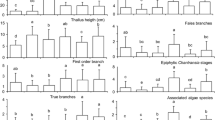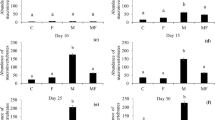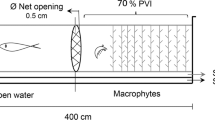Abstract
Macrophytes have a fundamental structuring role in aquatic environments. Several authors have suggested that trophic interactions are particularly mediated by aquatic plants. In the current article, we evaluated the effects of the structural heterogeneity provided by Eichhornia azurea (Kunth) roots on predation and habitat use by the small fish Moenkhausia sanctaefilomenae (Steindachner). We tested the hypotheses that (i) high structural heterogeneity protects macroinvertebrates against predation by M. sanctaefilomenae; (ii) distinct prey types are differently protected by the refuge provided by roots; and (iii) the behavior of M. sanctaefilomenae is affected by the structural heterogeneity provided by macrophyte roots. To test these hypotheses, we performed an experiment in 20 l aquaria in which macroinvertebrates (Cypricercus sp. and Chironomus sp.) were exposed to M. sanctaefilomenae predation for 4 h under three structural heterogeneities, represented by different root densities. High structural heterogeneity protected macroinvertebrates against predation. Additionally, E. azurea roots similarly protected different prey species. The macrophyte spatial structure substantially changed the habitat use of M. sanctaefilomenae. In general, our results corroborated the hypothesis that the structural heterogeneity provided by E. azurea roots significantly affects predation and habitat use by M. sanctaefilomenae.



Similar content being viewed by others
References
Abrahams, M. V. & A. Sutterlin, 1999. The foraging and antipredator behaviour of growth-enhanced transgenic Atlantic salmon. Animal Behaviour 58: 933–942.
Agostinho, A. A., L. C. Gomes & H. F. Julio Jr., 2003. Relações entre macrófitas aquáticas e peixes. In Thomaz, S. M. & L. M. Bini (eds), Ecologia e manejo de macrófitas aquáticas. Eduem, Maringá: 261–280.
Agostinho, A. A., S. M. Thomaz, L. C. Gomes & L. S. M. A. Baltar, 2007. Influence of the macrophyte Eichhornia azurea on fish assemblage of the Upper Paraná River Floodplain (Brazil). Aquatic Ecology 41: 611–619.
Brendonck, L., J. Maes, W. Rommens, N. Dekeza, T. Nhiwatiwa, M. Barson, V. Callebaut, C. Phiri, K. Moreau, B. Gratwicke, M. Stevens, N. Alyn, E. Holsters, F. Ollevier & B. Marshall, 2003. The impact of water hyacinth (Eichhornia crassipes) in a eutrophic subtropical impoundment (Lake Chivero, Zimbabwe). II. Species diversity. Archiv für Hydrobiologie 158: 389–405.
Burks, R. L., E. Jeppesen & D. M. Lodge, 2001. Littoral zone structures as Daphnia refugia against fish predators. Limnology and Oceanography 46: 230–237.
Camargo, A. F. M. & F. A. Esteves, 1996. Influence of water level variation on biomass and chemical composition of the aquatic macrophyte Eichhornia azurea (KUNTH) in an oxbow lake of the Rio Mogi-Guaçu (São Paulo, Brazil). Archiv für Hydrobiologie 135: 423–432.
Declerck, S., J. Vandekerkhove, L. Johansson, K. Muylaert, J. M. Conde-Porcuna, K. Van der Gucht, C. Pérez-Martínez, T. Lauridsen, K. Schwenk, G. Zwart, W. Rommens, J. López-Ramos, E. Jeppesen, W. Vyverman, L. Brendonck & L. De Meester, 2005. Multi-group biodiversity in shallow lakes along gradients of phosphorus and water plant cover. Ecology 86: 1905–1915.
Dibble, E. D., K. J. Killgore & G. O. Dick, 1996. Measurement of plant architecture in seven aquatic plants. Journal of Freshwater Ecology 11: 311–318.
Dibble, E. D., S. M. Thomaz & A. A. Padial, 2006. Spatial-complexity measured at a multi-scale among three aquatic plant species. Journal of Freshwater Ecology 21: 239–247.
Diehl, S., 1988. Foraging efficiency of three freshwater fishes: effects of structural complexity and light. Oikos 53: 207–214.
Grabowski, J. H. & S. P. Powers, 2004. Habitat complexity mitigates trophic transfer on oyster reefs. Marine Ecology Progress Series 277: 291–295.
Graça, W. J. & C. S. Pavanelli, 2007. Peixes da planície de inundação do alto rio Paraná e áreas adjacentes. EDUEM, Maringá.
Grenouillet, G., D. Pont & K. L. Seip, 2002. Abundance and species richness as a function of food resources and vegetation structure: juvenile fish assemblages in rivers. Ecography 25: 641–650.
Hahn, N. S., R. Fugi & I. F. Andrian, 2004. Trophic ecology of fish assemblages. In Thomaz, S. M., A. A. Agostinho & N. S. Hahn (eds), The upper Paraná River and its floodplain: physical aspects, ecology and conservation. Backhuys Publishers, Leiden: 247–270.
Hembre, L. K. & R. O. Megard, 2005. Timing of predation by rainbow trout controls Daphinia demography and the trophic status of a Minnesota lake. Freshwater Biology 50: 1064–1080.
Higuti, J., L. F. M. Velho, F. A. Lansac-Tôha & K. Martens, 2007. Pleuston communities are buffered from regional flood pulses: the example of ostracods in the Paraná River floodplain, Brazil. Freshwater Biology 52: 1930–1943.
Iglesias, C., N. Mazzeo, G. Goyenola, C. Fosalba, F. T. Mello, S. García & E. Jeppesen, 2008. Field and experimental evidence of the effect of Jenynsia multidentata, a small omnivorous–planktivorous fish, on the size distribution of zooplankton in subtropical lakes. Freshwater Biology. doi:10.1111/j.1365-2427.2008.02007.x.
Jacobsen, L. & M. R. Perrow, 1998. Predation risk from piscivorous fish influencing the diel use of macrophytes by planktivorous fish in experimental ponds. Ecology of Freshwater Fish 7: 78–86.
Jacobsen, L., M. R. Perrow, F. Landkildehus, M. Hjørne, T. L. Lauridsen & S. Berg, 1997. Interactions between piscivores, zooplanktivores and zooplankton in submerged macrophytes: preliminary observations from enclosure and pond experiments. Hydrobiologia 342/343: 197–205.
Jeppesen, E., Ma. Søndergaard, Mo. Søndergaard & K. Cristoffersen, 1998. The structuring role of submerged macrophytes in lakes. Springer, New York.
Jeppesen, E., J. P. Jensen, M. Søndergaard, M. Fenger-Grøn, M. E. Bramm, K. Sandby, P. H. Møller & H. U. Rasmussen, 2004. Impact of fish predation on cladoceran body weight distribution and zooplankton grazing in lakes during winter. Freshwater Biology 49: 432–447.
Jeppesen, E., M. Meerhoff, B. A. Jacobsen, R. S. Hansen, M. Søndergaard, J. P. Jensen, T. L. Lauridsen, N. Mazzeo & C. W. C. Branco, 2007. Restoration of shallow lakes by nutrient control and biomanipulation—the successful strategy varies with lake size and climate. Hydrobiologia 581: 269–285.
Lansac-Tôha, F. A., L. F. M. Velho & C. C. Bonecker, 2003. Influência de macrófitas aquáticas sobre a estrutura da comunidade zooplanctônica. In Thomaz, S. M. & L. M. Bini (eds), Ecologia e manejo de macrófitas aquáticas. Eduem, Maringá: 231–242.
Lehtiniemi, M., 2005. Swim or hide: predator cues cause species specific reactions in young fish larvae. Journal of Fish Biology 66: 1285–1299.
Loureiro-Crippa, V. E., 2006. Dieta, hábitos alimentares e morfologia trófica de peixes de pequeno porte, em lagoas da planície do alto rio Paraná, Brasil. Ph.D. thesis, Maringá State University, Maringá, Paraná, Brazil.
Meerhoff, M., N. Mazzeo, B. Moss & L. Rodriguez-Gallego, 2003. The structuring role of free-floating versus submerged plants in a subtropical shallow lake. Aquatic Ecology 37: 377–391.
Meerhoff, M., C. Fosalba, C. Bruzzone, N. Mazzeo, W. Noordoven & E. Jeppesen, 2006. An experimental study of habitat choice by Daphnia: plants signal danger more than refuge in subtropical lakes. Freshwater Biology 51: 1320–1330.
Meerhoff, M., J. M. Clementez, F. T. Mello, C. Iglesias, A. R. Pedersen & E. Jeppesen, 2007a. Can warm climate-related structure of littoral predator assemblies weaken the clear water state in shallow lakes? Global Change Biology 13: 1888–1897.
Meerhoff, M., C. Iglesias, F. T. Mello, J. M. Clemente, E. Jensen, T. L. Lauridsen & E. Jeppesen, 2007b. Effects of habitat complexity on community structure and predator avoidance behaviour of littoral zooplankton in temperate versus subtropical shallow lakes. Freshwater Biology 52: 1009–1021.
Mormul, R. P., L. A. Vieira, S. P. Júnior, A. Monkolski & A. M. dos Santos, 2006. Sucessão de invertebrados durante o processo de decomposição de duas plantas aquáticas (Eichhornia azurea e Polygonum ferrugineum). Acta Scientiarum Biological Sciences 28: 109–115.
Pelicice, F. M. & A. A. Agostinho, 2006. Feeding ecology of fishes associated with Egeria spp. patches in a tropical reservoir, Brazil. Ecology of Freshwater Fish 15: 10–19.
Piana, P. A., L. C. Gomes & A. A. Agostinho, 2006. Comparison of predator-prey interaction models for fish assemblages from the neotropical region. Ecological Modelling 192: 259–270.
Priyadarshana, T., T. Asaeda & J. Manatunge, 2001. Foraging behaviour of planktivorous fish in artificial vegetation: the effects on swimming and feeding. Hydrobiologia 442: 231–239.
Rantala, M. J., J. Ilmonen, J. Koskimäki, J. Suhonen & K. Tynkkynen, 2004. The macrophyte, Stratiotes aloides, protects larvae of dragonfly Aeshna viridis against fish predation. Aquatic Ecology 38: 77–82.
Richmond, S. & D. C. Lasenby, 2006. The behavioural response of mayfly nymphs (Stenonema sp.) to chemical cues from crayfish (Orconectes rusticus). Hydrobiologia 560: 335–343.
Sammons, S. M. & M. J. Maceina, 2006. Changes in diet and food consumption of largemouth bass following large-scale hydrilla reduction in Lake Seminole, Georgia. Hydrobiologia 560: 109–120.
Savino, J. & R. A. Stein, 1982. Predator-prey interaction between largemouth bass and bluegills as influenced by simulated, submerged vegetation. Transactions of the American Fisheries Society 111: 255–266.
Sheffer, M., 1997. On the implications of predator avoidance. Aquatic Ecology 31: 99–107.
Snickars, M., A. Sandström & J. Mattila, 2004. Antipredator behaviour of 0+ year Perca fluviatilis: effect of vegetation density and turbidity. Journal of Fish Biology 65: 1604–1613.
Statsoft, Inc., 2005. STATISTICA (data analysis software system) version 7.1 for Windows: statistics. STATSOFT, Inc., Tulsa.
Takeda, A. M., G. M. Souza-Franco, S. M. Melo & A. Monkolski, 2003. Invertebrados associados às macrófitas aquáticas da planície de inundação do alto rio Paraná. In Thomaz, S. M. & L. M. Bini (eds), Ecologia e manejo de macrófitas aquáticas. Eduem, Maringá: 243–260.
Thomaz, S. M., E. D. Dibble, L. R. Evangelista, J. Higuti & L. M. Bini, 2008. Influence of aquatic macrophyte habitat complexity on invertebrate abundance and richness in tropical lagoons. Freshwater Biology 53: 358–367.
Vieira, L. C. G., L. M. Bini, L. F. M. Velho & G. R. Mazão, 2007. Influence of spatial complexity on the density and diversity of periphytic rotifers, microcrustaceans and testate amoebae. Fundamental and Applied Limnology 170: 77–85.
Warfe, D. M. & L. A. Barmuta, 2004. Habitat structural complexity mediates the foraging success of multiple predator species. Oecologia 141: 171–178.
Warfe, D. M. & L. A. Barmuta, 2006. Habitat structural complexity mediates food web dynamics in a freshwater macrophyte community. Oecologia 150: 141–154.
Wooton, R. J., 1999. Ecology of Teleost Fishes, 2nd ed. Kluwer Academic Publishers, Dordrecht.
Acknowledgments
We acknowledge Dr. Leonardo Maltchik for his valuable comments during the creation of this article. We are also grateful to Dr. Steven Declerck and one anonymous reviewer for valuable comments during previous drafts of this article. We also acknowledge the Program of Graduation in Ecology of Inland Waters and the NUPELIA (Nucleon of Research in Limnology, Ichthyology and Aquaculture) of Maringá State University for the facilities. A. A. Padial received a student fellowship from Coordenação de Aperfeiçoamento de Pessoal de Nível Superior (CAPES). S. M. Thomaz and A. A. Agostinho are researchers of the Brazilian Council of Research (CNPq) and acknowledge this agency for long-term funding.
Author information
Authors and Affiliations
Corresponding author
Additional information
Handling editor: S. Declerck
Rights and permissions
About this article
Cite this article
Padial, A.A., Thomaz, S.M. & Agostinho, A.A. Effects of structural heterogeneity provided by the floating macrophyte Eichhornia azurea on the predation efficiency and habitat use of the small Neotropical fish Moenkhausia sanctaefilomenae . Hydrobiologia 624, 161–170 (2009). https://doi.org/10.1007/s10750-008-9690-8
Received:
Revised:
Accepted:
Published:
Issue Date:
DOI: https://doi.org/10.1007/s10750-008-9690-8




